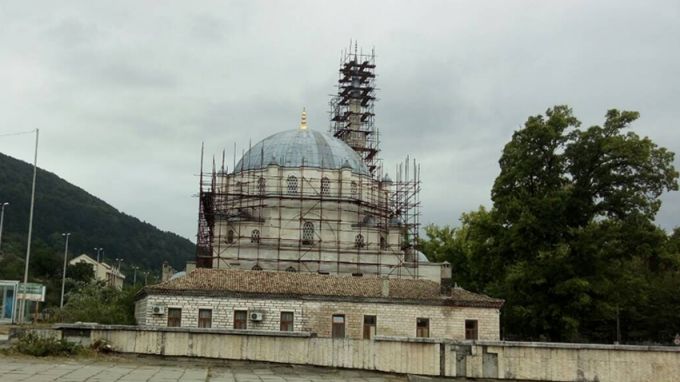 6
6
Shumen is a town known as one of the centers of the Bulgarian National Revival with its cultural and spiritual life, and where the spirit of past times can still be felt. If you go along the cobblestone street of "Tsar Osvoboditel" towards the Tombul Mosque, you will pass through the museum houses of some of the most prominent Bulgarian intellectuals and persons from the Revival, such as Panayot Volov, Lajos Kossuth, Pancho Vladigerov, Dobri Voynikov. Shumen is the birth place of Metropolitan Kliment of Turnovo (with secular name of Vassil Drumev), as well as the first mufti of Muslims in Bulgaria - Mehmet Muhyiddin. The mosque is located in the western part of the city, where the city center used to be in the past.
“To every thing there is a season, and a time to every purpose under the heaven... There is a time to break down, and a time to build up;" One starts thinking about these words from the Book of Ecclesiastes when approaching the Tombul Mosque - a Muslim temple that during the Bulgarian National Revival period was one of the most important religious, cultural and educational centers of Muslims in these lands. Besides being one of the symbols of Shumen, it is also a national monument of culture, part of the 100 National Tourist Sites of Bulgaria, but because of ongoing restoration work in recent years, the number of tourists visiting the mosque has decreased significantly.Tombul mosque was built in 1744 by benefactor Sheriff Halil Pasha and the mosque was named after him, but due to its round dome, which in Turkish is known as "tambul", the population started calling it "Tombul Mosque". The architectural style of the temple is influenced by the oriental “tulip” architectural style that originated in the early 18th century. The style is characterized by the presence of elements of the French Baroque. All parts of the architectural complex are included in a joint composition and are connected through patios. In the prayer hall one enters through an open entrance with high arcades in Moorish style. In his book “The Secrets of Tombul Mosque” Prof. Dobrin Dobrev of the Shumen University writes: "Tombul mosque is often described as one of the largest Muslim religious buildings on the Balkan Peninsula. The presence of a rich library that contains 800 manuscripts and 1500 old books is also traditionally pointed out."
In 2004, a study concerning the renovation of the mosque was carried out. In the period 2005-2008, some emergency activities on strengthening the temple's construction were carried out. Because of lack of funds, the restoration project was paused until 2016 when it was re-launched thanks to donations. Work includes a construction stage and a stage of artistic restoration.
"Tombul Mosque, according to me, in comparison to all mosques I have seen, excluding those under construction in the Middle East, has the richest decorations," says head of the artistic restoration stage Lyubomir Vodenicharov and adds:
"The most complicated thing in this mosque is that there are two periods of decoration exposed. One is the original one from the middle of the 18th century. And the other is a later one from the 19th century. This was necessary because the first decoration was linked to the aesthetics of Alevism. In the 19th century, due to some faults and the aesthetic considerations mentioned, the decoration was overwritten, but already with local elements of the Turkish Baroque used. We have reached an agreement that when a layer of the first period was discovered, it would be restored, and when a layer of the second period was discovered, it would be restored, too. We try to make sure that there is a distinct difference. Everything in the decoration is impressive because it is all hand-painted - no stencils were used."
English: Alexander Markov
Photos: Uzlem Tefikova and Radio ShumenA six-day handicrafts festival in Veliko Tarnovo kicks off the celebrations of Bulgaria's 116th anniversary of independence , reports BNR correspondent Zdravka Maslyankova. More than 80 craftsmen from all over the country will take part in the..
St. Sophia - the church that gave the Bulgarian capital its present-day name - is dwarfed by St. Alexander Nevsky Cathedral , which towers in the centre of the square of the same name. With its white façade, gleaming gold and green domes and beautiful..
A few days before the start of the new 2024-2025 school year, the idea of a complete ban on mobile phones in school is emerging in public space . The main reasons for such a decision are the low success rate in school, the absent-mindedness of..
An unusual opening of the new school year was made by the students and teachers of the Bulgarian school "Asen and Ilia Peikov" in Rome and Florence. The..
A six-day handicrafts festival in Veliko Tarnovo kicks off the celebrations of Bulgaria's 116th anniversary of independence , reports BNR correspondent..
On 17 October, after a break of several years due to the Covid-19 pandemic, the fifth edition of the "EcoMunicipality - Sustainable City and Society"..

+359 2 9336 661
